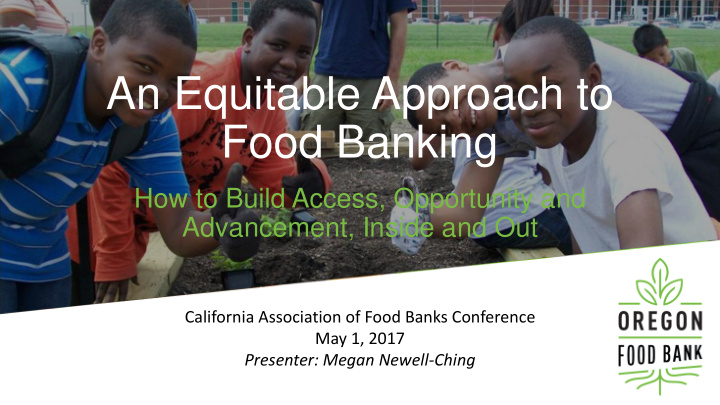



An Equitable Approach to Food Banking How to Build Access, Opportunity and Advancement, Inside and Out California Association of Food Banks Conference May 1, 2017 Presenter: Megan Newell-Ching
Oregon Food Bank • 160+ staff • 4 branch locations • 17 PDOs • 37 counties • 970+ food assistance programs with 700+ organizational partners
Oregon Food Bank Demographics Staff/Board People Served (pantries) • 15% of staff identify as • White: 74% people of color • Hispanic: 13% • 29% of OFB board identify • African American: 3% as people of color • American Indian or Native • 0% of executive leadership Alaskan: 3% identify as people of color • Asian: 2% • Native Hawaiian or Other Pacific Islander: 1% • Mixed Race: 4%
Beyond the Can OFB’s Mission To eliminate hunger and its root causes…because no one should be hungry In order to end hunger, we believe we must also address the root causes of hunger through public policy, nutrition and garden education, and public awareness.
Why Equity, Why Now?
Our Equity Journey
Timeline 2014 2015 2016 2017 • Strategic Plan • Equity Team • Equity Sub- • Equity Statement Launch formed committees approved by board • Staff • 3-day all staff • Equity Lens engagement on training completed • Formal Equity internal culture Planning • Regular staff • Board training • Assessment and dialogues • Increasing FTE • Organizational determination of for internal • Partner Equity underserved equity Alignment Assessment areas & Initiative & • External • Community populations Link2Feed communications Equity Launch launch Coordinator • School Pantry hired • Culturally Focus Groups specific • Barrier removal farm/garden pilot for partnerships education launch programs
Lessons Learned • Leadership buy-in is key • Engage the board early in the process • Plan to capture staff momentum post- training • On-going training for new employees • It will feel hard and you will make mistakes, keep going!
The Daily Work is… Shifting perspective and slowing down processes to make more space for reflection, community validation and thoughtful action.
At OFB this looks like… • On-going cross- • Tools and support for department/cross- staff & board functional teams and • Equity Statement initiatives • Equity Lens • E-Team • Required and optional • Inclusive Culture learning/engagement opportunities • HR • Communication • Relationship building (internal/external) • Shifting budget and work • Staff capacity (FTE plan priorities dedicated to equity & inclusion)
Equity Statement
What is an Equity Lens?
Equity Lens
What is an Equity Lens? A quality improvement tool used for planning, decision-making, and resource allocation that ideally leads to more racially equitable policies, program delivery and ultimately more equitable outcomes for our clients. At its core, it is a set of principles, reflective questions, and processes that functions at the individual, institutional, and systemic levels by: • proactively seeking to eliminate inequities and advance equitable solutions; • shifting the way we make decisions and think about our work; and • identifying clear goals and objectives, measurable outcomes for successful implementation
OFB Equity Lens Key Questions • In considering your decision, what are you hoping to achieve? • How will you intentionally involve a diverse set of stakeholders, including those who may be impacted? • How might your beliefs and biases impact this decision? • How does this decision advance racial equity? • How will the final decision be shared?
Equity in Action at OFB
Where i is equity s showing up? • Advocacy: client engagement, supporting “non-food” policy work • Agency Relations: new partnerships, agency segmentation, agency education • Education Programs: culturally specific and translated curricula, barrier removal to program participation, culturally specific partners • Operations: culturally appropriate foods, increased capacity for underserved areas (delivery, etc.) • HR: staff training, recruitment, hiring & onboarding, dedicated equity FTE
Agency Relations • Agency Training Series • Partner Alignment Initiative (agency segmentation) • Translation & Interpretation • Client engagement & leadership development
Garden Programs • New Garden Partners: First Foods Garden, Mudbone Grown, Black Food Sovereignty Council • Seed-to-Supper culturally specific curriculum translation • Barrier removal pilot (childcare, interpretation, transportation) • Spanish speaking volunteer shifts • Mural designed by incarcerated Seed-to Supper participants
What have w e we e wor orked on on ou outsid ide of of foo ood p pol olic icy? What are the non-food policies we have supported: • Minimum Wage Increase • Housing • Emergency Housing Funds • Portland Housing Bond Campaign • Just Cause eviction legislation • Affordable Housing • Payday Lending • Temporary Assistance to Needy Families (TANF) • Earned Income Tax Credit/Child tax credit • Transportation • Affordable Healthcare
RESOURCES • Coalition of Communities of Color Protocol for Culturally Responsive Organizations • OFB Equity Statement • Meyer Memorial Trust- DEI Resources • Nonprofit Quarterly- DEI Article Series • Center for Equity & Inclusion • Partners for a Hunger Free Oregon Equity Commitment
Contact Information Megan Newell-Ching, Associate Director Partnerships & Programs mnewellching@oregonfoodbank.org 503-419-4186
Recommend
More recommend